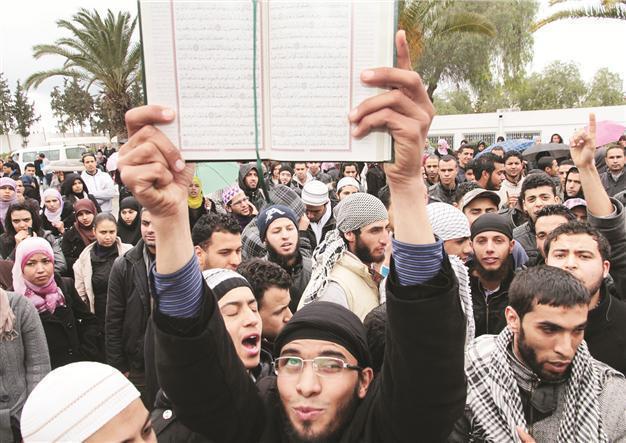Hardliners threaten Arab Spring gains in Tunisia
TUNIS, Tunisia - The Associated Press

An ultraconservative Muslim is seen demonstrating with a Quran at the Manouba university in Tunis in this file photo.
Thousands of hardcore Muslims chant against Jews. Youths rampage through cities at night in protest of “blasphemous” art. A sit-in by religious students degenerates into fist fights and the desecration of Tunisia’s flag.In the birthplace of the Arab Spring, the transition from dictatorship to democracy has been, for the most part, smoother than in neighboring countries, with no power-hungry military or armed militias to stifle the process. But as a moderate Islamist party rules with the help of secular forces, an unexpected threat has emerged: the increasing boldness of ultraconservative Muslims, known loosely as Salafis, who want to turn this North African country of 10 million into a strict Islamic state.
Tunisia’s Salafis are estimated to number only in the tens of thousands, but their organized and frequent protests against perceived insults to Islam, especially by artists, have rocked the country.
They have succeeded in mobilizing disaffected and angry youth much more effectively than secular opposition parties. As Salafis thrive in the new atmosphere of freedom of expression, they are aggressively attacking the free expression of those they see to be insulting Islam. Their main target: artists who themselves have used democratic upheaval to raise sharp, often provocative, questions about the relationship between religion and society.
Film lights fire
A film called “Neither Allah nor Master” about secularism by an atheist director, an animated film portraying God as an old man that was broadcast on TV, and most recently an art exhibit dabbling in religious themes have all provoked the wrath of the Salafis. The Spring of the Arts exhibit in the wealthy Tunis suburb of La Marsa triggered June riots that left one dead and 100 injured. Many of the paintings questioned religion’s role in society, including some clearly skewering Salafis. There were images of veiled women hanging from punching bags in a boxing ring, veiled women buried in stones, and paintings of demonic bearded faces.
The Islamist-led government has tread carefully around Salafi demonstrations, conscious that they themselves were once victims of government oppression and fearful of further radicalizing the Salafis.
For Tunisian authorities, grappling with the Salafis is made all the harder because of the fact that they have not coalesced into an articulate, united movement, but are comprised of different groups, some which may even be under the manipulation of secular remnants of the old regime. That contrasts with Egypt, where Salafis have formed political parties and participate in politics.
“They were influenced by the Salafi discourse coming out of the Gulf countries and diffused by the Salafi satellite channels all through the 1990s,” explained Slaheddine Jourchi, a Tunisian writer and human rights activist who has closely studied Islamist movements. “They saw the Salafi discourse as the most pure in Islam.” With the fall of the dictatorship, Salafis are now free to spread their message to the rest of the country.
Sami Brahim, an expert on Islamist movements in Tunisia who runs a cultural center near the art gallery in La Marsa, expects the whole Salafi movement to subside with time because it is a cultural import funded by the Gulf States.
“Salafism doesn’t yet have the courage to take part in politics since from the beginning it hasn’t been an organized movement and it doesn’t have a very well elaborated discourse,” said Brahim. “It would just need a healthy atmosphere, real freedoms and a relatively successful economy for the Tunisian Salafi movement to be marginalized.”
















